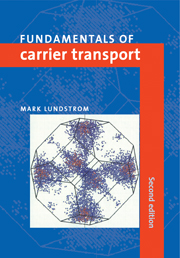Book contents
- Frontmatter
- Contents
- Preface to the second edition
- Preface to the first edition
- An overview
- 1 The quantum foundation
- 2 Carrier scattering
- 3 The Boltzmann transport equation
- 4 Low-field transport
- 5 Balance equations
- 6 Monte Carlo simulation
- 7 High-field transport in bulk semiconductors
- 8 Carrier transport in devices
- 9 Transport in mesoscopic structures
- Appendix 1 Summary of indicial notation and tensors
- Appendix 2 Some useful integrals
- Index
Preface to the second edition
Published online by Cambridge University Press: 30 March 2010
- Frontmatter
- Contents
- Preface to the second edition
- Preface to the first edition
- An overview
- 1 The quantum foundation
- 2 Carrier scattering
- 3 The Boltzmann transport equation
- 4 Low-field transport
- 5 Balance equations
- 6 Monte Carlo simulation
- 7 High-field transport in bulk semiconductors
- 8 Carrier transport in devices
- 9 Transport in mesoscopic structures
- Appendix 1 Summary of indicial notation and tensors
- Appendix 2 Some useful integrals
- Index
Summary
The first edition of this book was written in a period when the drift–diffusion-based description of semiconductor devices was beginning to lose validity and many kinds of interesting transport effects (e.g. velocity overshoot, ballistic transport, real-space transfer, etc.) and their implications for devices were being explored. Since that time, semiconductor devices have continued to shrink in size, so that engineers and device researchers now face these issues daily. When the first edition was written, quantum transport in mesoscopic structures was also an active research field, with many uncertainties being debated. In the intervening years, this field has matured; the general principles are now understood and are becoming relevant to semiconductor technologists as devices continue their relentless march to microscopic dimensions.
The goals of the second edition are much like those of the first. The book is an attempt to help students with little formal training in quantum mechanics or solid state physics (i.e., the typical graduate of an undergraduate electrical engineering program) understand the fundamental concepts of carrier transport in semiconductors. Writing the second edition was an opportunity to update and clarify material in the first edition and to treat new topics. The most significant change in the second edition is the addition of Chapter 9 on transport in mesoscopic structures, a topic that device engineers now deal with.
Two classes of graduate students worked through early versions of this text and helped me to clarify the presentation and reduce the number of typos and errors.
- Type
- Chapter
- Information
- Fundamentals of Carrier Transport , pp. xiiiPublisher: Cambridge University PressPrint publication year: 2000



